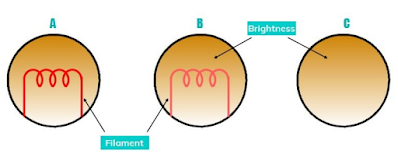Pyrometer
PYROMETER
A pyrometer is a type of remote-sensing thermometer used to measure the temperature of distant objects. It detects the temperature of an object’s surface temperature, which depends on the radiation (infrared or visible) emitted from the object. Pyrometer is also known as an Infrared thermometer or Radiation thermometer or non-contact thermometer.
The pyrometer offers the following features, such as
b). Easy measurement in places which are difficult to access
c). Very precise and Reliable temperature measurement technology
Working Principle
The basic principle of the pyrometer is that it measures the object’s temperature by sensing the heat/radiation emitted from the object without making contact with the object.
Types of Pyrometers
Pyrometers can be broadly classified into two categories.
b). Infrared / Radiation pyrometers
Optical Pyrometer
Optical pyrometers work on the disappearing filament principle. In order to measure temperature, the brightness generated by the radiation of the unknown source or hot body whose temperature is to be determined is compared with that of the reference lamp. The brightness of the reference lamp can be adjusted so that its intensity is equal to the brightness of the hot body under consideration. The light intensity of the object depends on its temperature, irrespective of its wavelength. A battery supplies the current required for heating the filament. The current flowing through the filament is adjusted by means of a rheostat and an ammeter is used to measure it. The current passing through the circuit is proportional to the temperature of the unknown source.
An optical pyrometer essentially consists of an eyepiece, by means of which the filament and the source are focused so that they appear superimposed, enabling a clear view for the observer. Between the eyepiece and the reference lamp, a red filter is positioned, which helps narrow down the wavelength band and attain monochromatic conditions. An absorption filter helps operate the lamp at reduced intensity, thereby enhancing the life of the lamp. The current in the reference lamp can be varied by operating the rheostat and can be measured using the ammeter. Thus, the intensity of the lamp can be altered.
There may be three possibilities, such as
B. When the filament is “BRIGHT”. Then the source object is cooler than the reference temperature or we can say that the filament temperature is hotter than the source temperature.
C. When the filament “DISAPPEARS”. So we can say that the temperature of the source object and reference temperature is the same.
Advantages
i). Assembly is simple and portable.
ii). Flexible and easy to operate.
iii). Provides a very high accuracy with the tolerance of ±5 ºC.
iv). No need to be in direct contact with the object whose temperature is being measured.
v). Useful for the temperature measurement of the moving objects.
vi). It can be used easily at a place where a physical approach is possible to measure the temperature.
Disadvantage
i). Measurement is completely based on the light intensity, it can be useful only to measure relatively high temperature.
ii). Temperature measurement at short intervals is not possible.
iii). Emissivity errors may affect measurement.
iv). Optical pyrometers are used for the measurement of clean gases only.
Infrared / radiation pyrometers
Infrared / radiation pyrometers measure the temperature of an object from the radiation emitted by the object. They can handle thermal radiation in the infrared region usually 2 ~ 14 µm (80 ~ 550 µin). The radiation is directed at a detector, which is capable of producing an electric current when it is partly heated. The detector may be either thermopile or thermocouple.

Radiation Pyrometer
As shown in the figure, the radiation pyrometer has an optical system such as it has an optical lens, mirror, and adjustable eyepiece. The heat energy emitted from the hot body is passed on to the optical lens, which collects it and is focused on to the detector with the help of the mirror and eye piece arrangement. The detector converts the collected energy into an electrical signal to drive a temperature display.
Radiation pyrometers find applications in the measurement of temperature in corrosive environments and in situations where physical contact is impossible. In addition, radiations of moving targets and invisible rays can also be measured. It is also used for temperature measurement when sources under consideration have near-black body conditions.
Advantages
i). Non contact type device.
ii). It has a high performance and moderate cost.
iii). High-temperature measurement can be accomplished.
iv). It has a fast speed response.
v). It has good stability.
vi). No need to be in physical contact with the object being measured.
Disadvantage
i). The design of the radiation pyrometer is complex.
ii). Errors in temperature measurement are possible due to emission of radiations to the atmosphere.
iii). The emissivity of the target material may affect the measurement.




